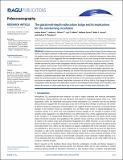The glacial mid-depth radiocarbon bulge and its implications for the overturning circulation
Author(s)
Stewart, Andrew L.; Adkins, Jess F.; Ferrari, Raffaele; Jansen, Malte F.; Thompson, Andrew F.; Burke, Andrea, Ph. D. Massachusetts Institute of Technology; ... Show more Show less
DownloadFerrari_The glacial.pdf (3.017Mb)
PUBLISHER_POLICY
Publisher Policy
Article is made available in accordance with the publisher's policy and may be subject to US copyright law. Please refer to the publisher's site for terms of use.
Terms of use
Metadata
Show full item recordAbstract
Published reconstructions of radiocarbon in the Atlantic sector of the Southern Ocean indicate that there is a mid-depth maximum in radiocarbon age during the Last Glacial Maximum (LGM). This is in contrast to the modern ocean where intense mixing between water masses results in a relatively homogenous radiocarbon profile. Ferrari et al. (2014) suggested that the extended Antarctic sea ice cover during the LGM necessitated a shallower boundary between the upper and lower branches of the meridional overturning circulation. This shoaled boundary lay above major topographic features associated with strong diapycnal mixing, isolating dense southern sourced water in the lower branch of the overturning circulation. This isolation would have allowed radiocarbon to decay and thus provides a possible explanation for the mid-depth radiocarbon age bulge. We test this hypothesis using an idealized, 2-D, residual-mean dynamical model of the global overturning circulation. Concentration distributions of a decaying tracer that is advected by the simulated overturning are compared to published radiocarbon data. We find that a 600 km (~5° of latitude) increase in sea ice extent shoals the boundary between the upper and lower branches of the overturning circulation at 45°S by 600 m and shoals the depth of North Atlantic Deep Water convection at 50°N by 2500 m. This change in circulation configuration alone decreases the radiocarbon content in the mid-depth South Atlantic at 45°S by 40‰, even without an increase in surface radiocarbon age in the source region of deep waters during the LGM.
Date issued
2015-07Department
Massachusetts Institute of Technology. Department of Earth, Atmospheric, and Planetary SciencesJournal
Paleoceanography
Publisher
American Geophysical Union (AGU)
Citation
Burke, Andrea et al. “The Glacial Mid-Depth Radiocarbon Bulge and Its Implications for the Overturning Circulation: Glacial Radiocarbon and Circulation.” Paleoceanography 30.7 (2015): 1021–1039. © 2015. American Geophysical Union.
Version: Final published version
ISSN
0883-8305